Painting and Finishing PowerPoint
1/40
There's no tags or description
Looks like no tags are added yet.
Name | Mastery | Learn | Test | Matching | Spaced |
|---|
No study sessions yet.
41 Terms
What are two critical safety practices when painting?
Always wear a respirator that has the proper filters for the paint you are using.
Always read and understand the Material Safety Data Sheet (MSDS).
What should you understand from reading the MSDS (Material Safety Data Sheet)?
What chemicals are in the paint
Precautions to be taken
What to do in case of exposure
Fire hazards
Other important information
What are some methods of paint removal? (List 6 methods)
Chemical Strippers
Application of chemicals to soften paint
Dry Strippers
Blasting of parts
Sanding of parts
Pyrolytic Stripping (use of heat to soften layers of paint)
What are hazards of paint strippers? (List 4 hazards)
Respiratory system damage
Eye damage
Skin damage
Harmful if internally consumed
Always adhere to the MSDS.
What is the process for paint stripping? (List 4 steps)
Mask all areas not to be stripped
Apply stripper and remove loosened paint
Clean with a solvent such as MEK (Methyl Ethyl Ketone) or Acetone
Blow out all seams and joints
What is MEK?
MEK stands for Methyl Ethyl Ketone.
It is a strong solvent used for cleaning surfaces and removing paint or adhesives.
What is involved in surface preparation before painting? (List 4 steps)
Surface must be clean of all paint, stripper, oil, dirt, or other debris
Thoroughly inspect for cracks, corrosion, and other defects; repair as necessary
Thoroughly clean surface either mechanically or chemically
Treat with a conversion coating if desired
(Surface preparation is for prepping to paint, not for paint removal.)
What are three types of primers? (List 3 primers)
Zinc Chromate
Wash Primer
Epoxy Primer
What is Zinc Chromate Primer known for?
Good corrosion resistance
Zinc Chromate is a standalone corrosion-inhibiting primer.
What is important to know when using Wash Primer?
Cures after a half hour (used in high production areas)
Care must be taken to ensure filiform corrosion is not set up in the application process
Wash Primer is a different type of primer that is acid-catalyzed and used for etching and priming metal surfaces quickly, often with very fast curing (like 30 minutes).
What is Epoxy Primer?
Two-part primer that gives the best corrosion protection of any modern primer
Better bond than Zinc Chromate
What are three types of topcoats? (List 3 topcoats)
Enamels
Acrylic Lacquers
Polyurethane
What are characteristics of Enamel topcoats?
Single-stage paint, dries slower, creates a hard glossy finish.
Produce a glossy finish that does not require rubbing
Abrasion resistance is not as good as polyurethanes
Single Stage Coat
Do note that ‘Enamel Polyurethane’ is not the same.
What are characteristics of Acrylic Lacquer topcoats?
Dries extremely fast, allows quick application of multiple coats.
Subsequent coats may be applied very rapidly
Used in production for a fast-finishing system
Dry extremely fast
What are characteristics of Polyurethane topcoats?
Very tough coating, requires mixing two parts (base and hardener) for chemical curing.
Very tough coating
When dry, polyurethane has a wet look
Two-part chemically cured paint
Do note that ‘Enamel Polyurethane’ is not the same.
What are types of painting equipment? (List 6 types)
Regulator
Pressure pot (still commonly used for large surfaces like aircraft)
Spray guns
Suction cup spray gun (older method, less common today)
Airless sprayers
HVLP (High Volume Low Pressure) equipment
What two types of respiratory protection are used when painting? (List 2 types)
Hood-type (Air-supplied) respirators
Cartridge-type respirators
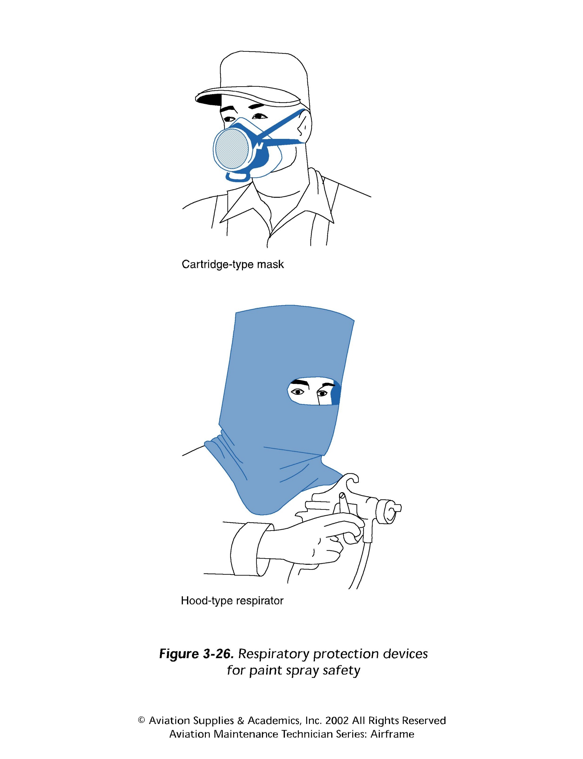
What is the purpose of an air regulator in a paint booth?
Maintains correct air pressure for painting operations
Ensures consistent spray pattern and quality
The air transformer contains a water drain trap, a filter element, a pressure regulator, and the necessary gauges and connection for spray guns.
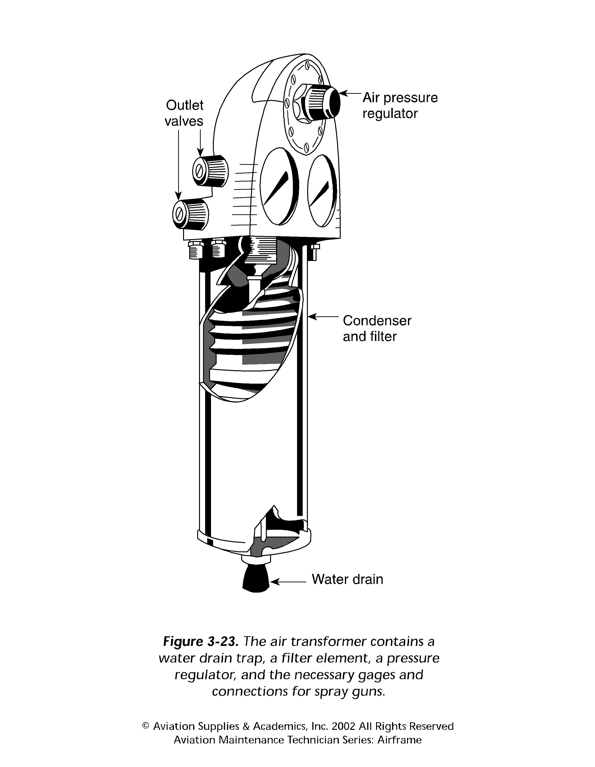
What is a pressure pot used for?
A pressure pot is used for painting an entire aircraft.

What is a suction cup spray gun used for?
A suction cup gun is used for applying the trim and for small paint jobs.
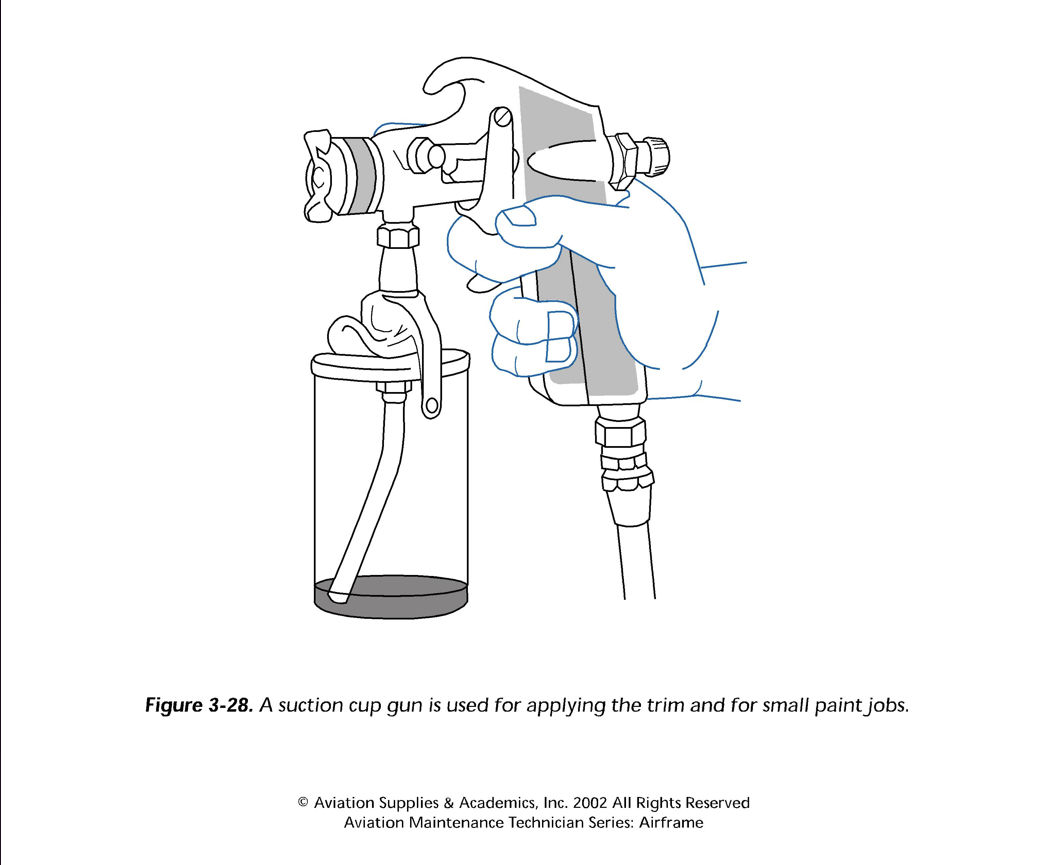
What is an air-atomizing spray gun used for?
An air-atomizing spray gun can be used as either a suction cup gun or a pressure pot gun by changing the fluid tip.
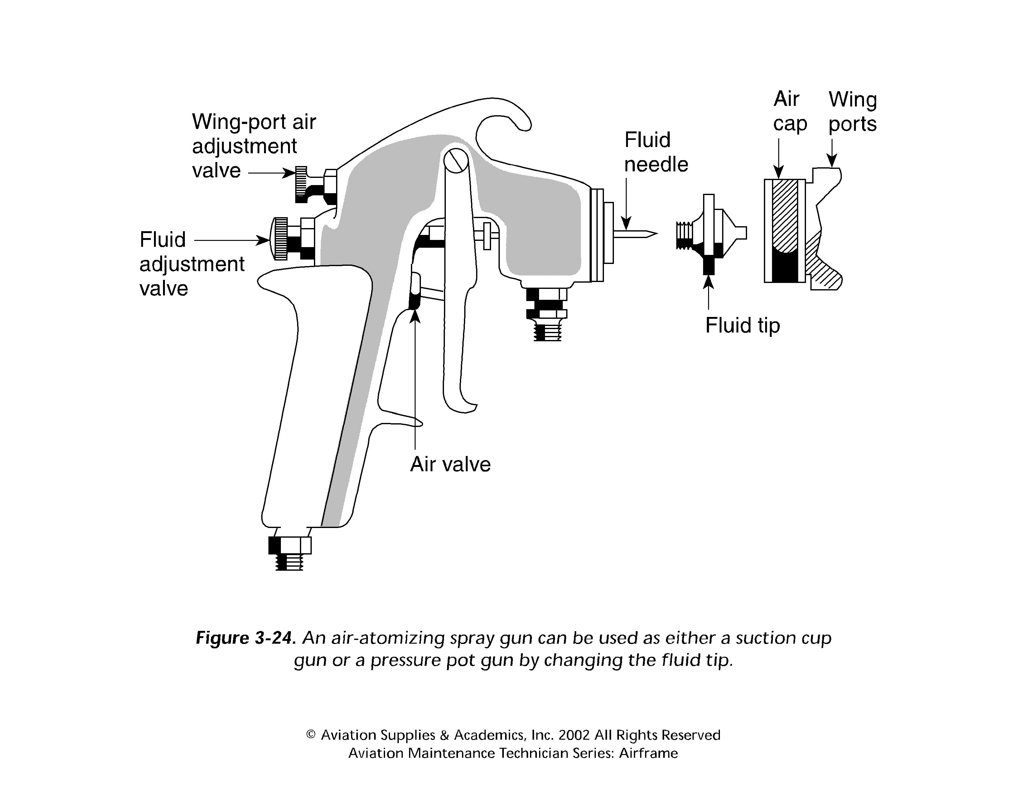
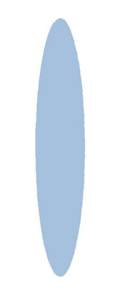
What spray pattern is it? What causes it?
Correct Spray Pattern

What spray pattern is it? What causes it?
Insufficient atomizing air pressure
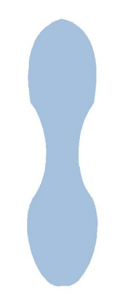
What spray pattern is it? What causes it?
Excessive atomizing air pressure

What spray pattern is it? What causes it?
Material build up on one side of nozzle

What spray pattern is it? What causes it?
One wing-port hole is plugged up.
What is the correct distance to hold the spray gun from the surface?
Hold the nozzle of the spray gun between 6 and 10 inches from the surface being sprayed.

What should you paint first when painting a surface?
Paint corners and edges first by spraying parallel to the corner
Then blend into the rest of the surface by spraying perpendicular to the corner
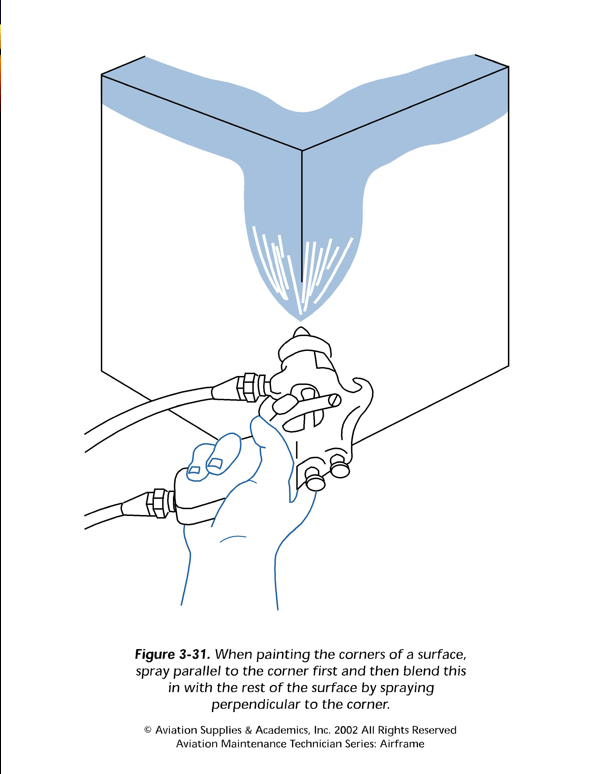
What are six common painting problems? (List 6 problems)
Runs
Dry, rough finish
Blushing
Fisheyes
Orange Peel
Spitting
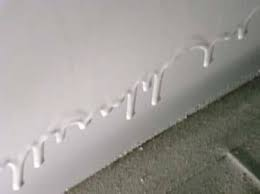
What causes runs (sags) in paint and how do you repair them?
Causes:
Application of paint is too thick
Air pressure too low
Incorrect viscosity of the paint
Repair:
Allow paint to dry
Sand and repaint
If in small area, just redo the job. Large area, sand it.
What causes dry spray (rough finish) and how do you repair it?
Causes:
Paint is too dry when it reaches the surface
Gun is too far from the surface
Improper thinner
Air pressure too high
Repair:
Sand and repaint
Pot life can cause this. If the paint sit for too long.
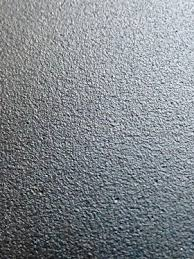

What causes blushing and how do you repair it?
Cause:
Condensation of water that occurs when solvents evaporate out of the paint
Repair:
Repaint the surface and add retarder to the paint to slow the evaporation
Blushing is usually caused by atmospheric conditions such as heat, cold, or moisture.
What causes fisheyes and how do you repair them?
Cause:
Contamination on the surface of the part
Repair:
Remove the paint and properly clean the part
Caused by contamination on the surface, such as oil, solvent, or hand contaminations.
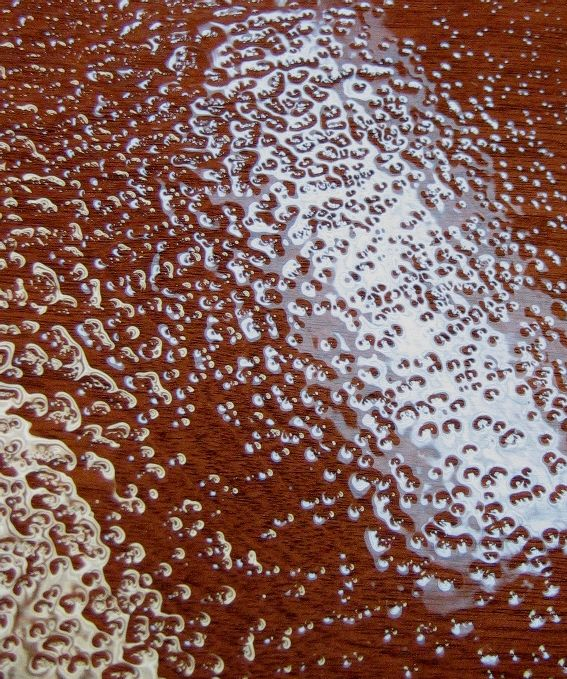
What causes orange peel and how do you repair it?
Causes:
Thinners that evaporate too quickly
Airflow over the surface
Improper paint mixing or paint too thick
Insufficient drying time between coats
Repair:
Polish the surface

What causes spitting during painting?
Air getting into the fluid because of low paint in the cup
Air leaking into the air line between the cup and nozzle
What are important steps for applying and removing painting tape?
Applying Tape:
Use only fine line painting tape
Use a flat tool or plastic scraper to fully flatten the tape down against the surface
Removing Tape:
Remove tape when the paint becomes tacky
Even if the edge is straight, still remove it when tacky; the paint will not overflow, and the edge will remain clean and sharp
When removing tape, pull it back over itself at an angle away from the paint line
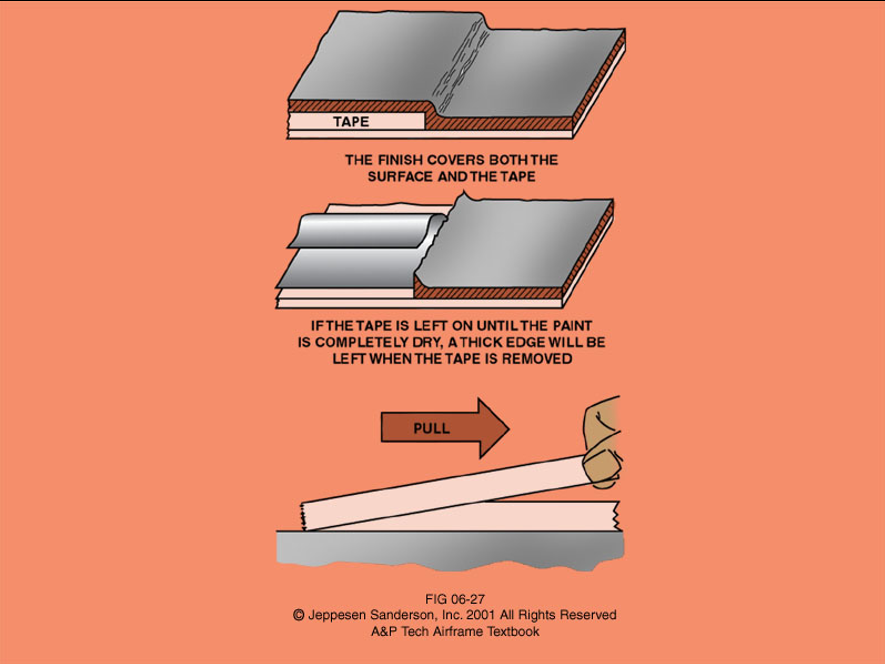
What are the steps to clean a spray gun? (List 4 steps)
Dump out unused paint
Rinse out the cup with solvent
Spray solvent through the gun while moving the trigger through its full travel
Dip the nozzle into solvent to loosen any paint around the tip
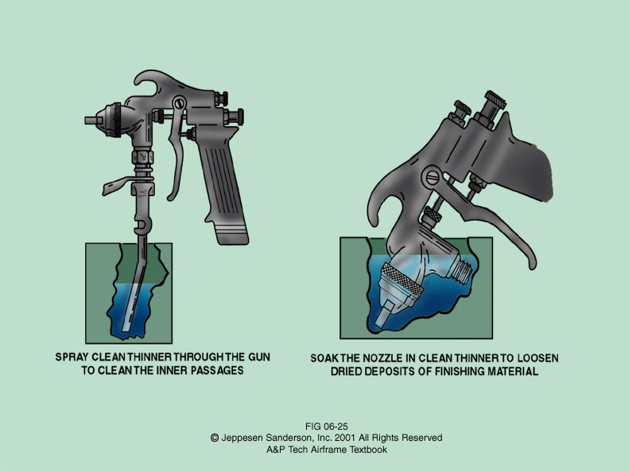
Where is the regulation for painting registration numbers found?
Found in FAR Part 45
FAR: Federal Aviation Regulations
What is FAR?
Federal Aviation Regulations
What are the three rules for ‘Aircraft Identification Plates?’
Clear Understanding: Manufactured Airplanes that apply to § 21.182
They must mark each aircraft with a fireproof plate that follows the following rules...
1. The plates must include information listed under § 45.13 by using an approved fireproof marking method.
(This means the markings themselves must be fireproof.)
2. The plates must be secured in a manner where it will not...
Be defaced
Be removed during normal services
Be lost or destroyed in an accident
3. Outside of the exceptions listed in paragraphs (d) through (h), the plates must be secured...
To the aircraft’s fuselage exterior
Needs to be legible to people on the ground
Must be either adjacent to and aft of the rear-most entrance door, or
On the fuselage surface near the tail surfaces
Additional Clarification:
Adjacent to the door means next to the door.
Aft of the door means behind the door toward the rear of the aircraft.
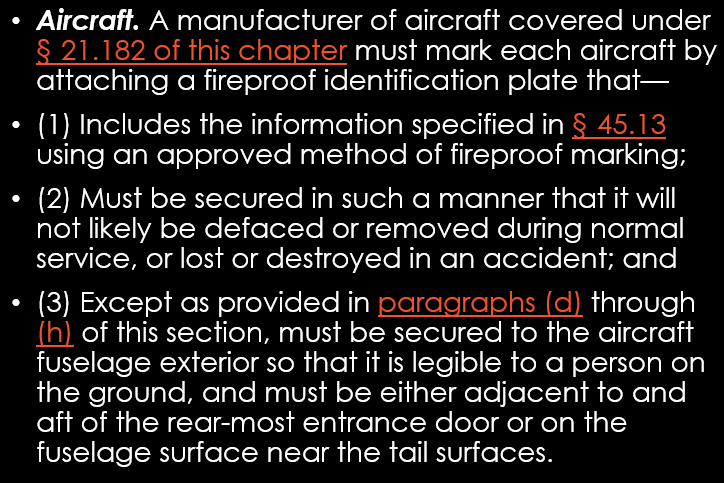
What are the four ‘Registration Mark Size Rules?’
Clear Understanding: Registration Mark Size Rules
US registered fixed-wing aircraft must have registration marks at least 12 inches high, except under certain conditions...
1. Aircraft built before November 1, 1981
May have smaller registration marks under old rules.
2. Aircraft with an FAA Experimental Certificate (under § 21.191 d, g, or i)
Marks can be at least 2 inches high if the aircraft:
Operates as an exhibition aircraft, amateur-built aircraft, or light-sport aircraft
Has a maximum cruising speed not exceeding 180 knots CAS
3. Exhibition, Antique, or Other Special Aircraft
Marks may follow § 45.22, allowing exceptions for these types.
4. Aircraft operating after March 7, 1988 through ADIZ or DEWIZ zones
Must display nationality and registration marks at least 12 inches high, even if temporary or permanent.
(ADIZ = Air Defense Identification Zone, DEWIZ = Distant Early Warning Identification Zone)
